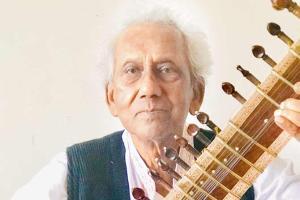Ravi Shankar's shishya and George Harrison's guru, veteran sitarist Shambhu Das on his new album of meditative music pieces

Shambhu Das. Pic /Ashema Chawla
Exchanging emails with one of the doyens of Indian classical music, sitar virtuoso Shambhu Das, is a lesson in humility. "Thank you for your interest in my music and life," the octogenarian says, when we write to him with an interview request. "Please allow me two hours to respond as I am busy with an important meeting," he adds, displaying none of the baggage demanding of an institution like him. Das later shares that he is only a servant to his art. "My advice to them [my students] is to see what I do, learn from there and practise hard."
The Toronto-based musician, one of the most famous disciples of Ravi Shankar and credited with teaching Beatles’ star George Harrison the sitar, has been living the last few years softly. It was over 14 years ago when Das made front-page news after he entered the Guinness World Record for the longest sitar marathon, which lasted 24 hours. Since then, he has been invested in teaching, meditation and yoga. "I get up in the morning at 5 am, meditate and pray, do yoga and then start my sitar practice." He has breakfast only after the first three tasks are completed. Afternoons are devoted to his students. His new album, Dhyanam & Shantivani (Ohm Music, Canada), originally recorded in the 1990s but never released, is an extension of the life he now lives. "Yoga means connecting oneself with a superior power, and getting there through meditation with classical music."
ADVERTISEMENT
The album was born out of two tragedies. "On September 15, 1992, Pandit Ravi Shankar’s son Shubho Shankar, whom I was very close to, passed away in California. My son Sandeep Das passed away [10 days later] on September 25 in Toronto. That period was very hard for us to carry on. I took a journey to the Himalayas to get some peace through meditation." A year later, he started composing the songs for Dhyanam & Shantivani. "I recorded it at a studio in Kolkata in 1995. A few months later, Pandit Ravi Shankar ji visited me. He listened to the music, liked it very much and endorsed it with his signature. He was so inspired by my meditative music pieces that soon after that, he and Harrison went on to record a CD of spiritual music in Madras [Chennai]."

Das and George Harrison
The six tracks, all of which are between 10 and 15 minutes long, comprise meditation music composed with Indian classical ragas. Das has used Hindu spiritual mantras, such as Maha Mrityunjaya Mantra, a meditation on Lord Shiva; a Ganesh Vandana; and Durga Mantra for world peace. Apart from the sitar, he has also incorporated other classical instruments such as the santoor, violin, flute and tanpura. The original tracks were re-mastered and edited by Radford Crasto, who is the executive producer.
Das’s tryst with yoga and meditation began early, even before he picked up the sitar at the age of 16. "I was born and raised in Varanasi, a city which has given us many great musicians. My father was a very spiritual person. He had a spiritual guru, and sometimes he would take me along with him. That’s where I first learned some aspects of hatha yoga and meditation." He began to look at a career in music seriously, when he joined Shankar in 1960s Bombay. "Ravi Shankar ji not only taught me music, but also invited me to live with him at his home in Malabar Hill and take care of his personal life. I was there till I came to Canada, to teach music, at the York University in 1970. Our relationship was out of this world." It was while in Bombay that he was introduced to Harrison, when the British musician came to learn the sitar from Shankar. "I would go to the Taj Mahal Hotel to make him practise the sitar and give a few new lessons, as per Ravi Shankar ji’s instructions. We became good friends and talked a lot about spirituality." His most amusing memory of their time together was when he took Harrison and his then wife, Pattie Boyd, to Varanasi. "They got a little high after drinking thandai, and kept laughing. We had arranged an elephant ride for them, and they just continued laughing through that ride and would not come down," he recalls, adding that their association continued till before Harrison passed away.
His wish now is that the compositions from his album, which have been with him for over two decades, and now available on iTunes and Google Play among other digital apps, reach the people they were meant to. "Dhyanam & Shantivani is not meant for a specialised audience, rather, for all those willing to experience new dimensions of awareness. Our scriptures have proved beyond doubt that supreme bliss is achieved through self-realisation, self-awareness or self-experience. Unstuck sound in Sanskrit is called anahata-nada. The highest aim of classical music is to reveal the universe, which is the anahata-nada."
Catch up on all the latest Mumbai news, crime news, current affairs, and also a complete guide on Mumbai from food to things to do and events across the city here. Also download the new mid-day Android and iOS apps to get latest updates
 Subscribe today by clicking the link and stay updated with the latest news!" Click here!
Subscribe today by clicking the link and stay updated with the latest news!" Click here!







